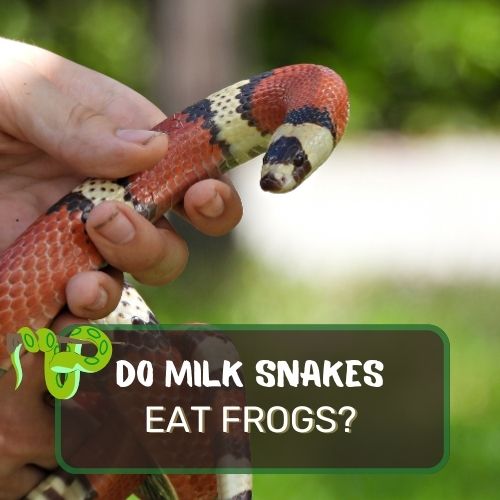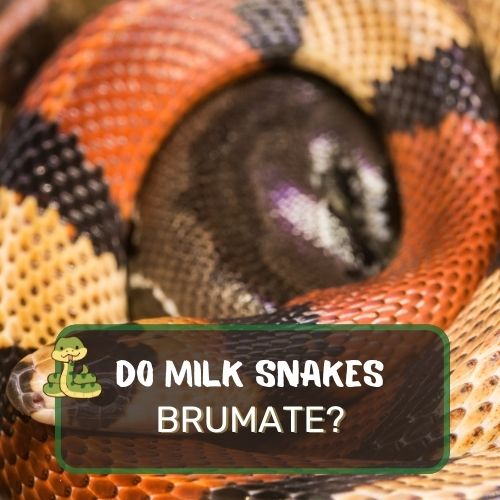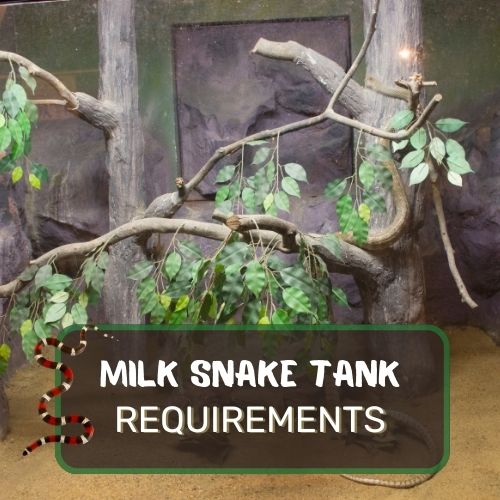Milk snakes: vibrant, intriguing, and often a topic of burning curiosity. Ever wondered about their eating habits or how long these mesmerizing creatures can go without a bite? You’re not alone!
Milk snakes, depending on their age and environment, can go without eating for varying durations. Juveniles typically need food every 5-7 days, while adults can wait 7-10 days between meals. In certain conditions, especially when brumating in colder seasons, they might fast for several weeks.
Dive into this comprehensive guide as we unravel the mysteries of the milk snake’s dietary patterns.
From the effects of temperature and age on their feeding frequency, the stark differences between wild and captive environments, to signs of starvation and essential feeding tips – we’ve covered it all.
So, get ready for an enlightening journey into the world of milk snakes!

Table of Contents
Factors That Affect Milk Snake’s Feeding Frequency
There is an interesting nugget: not all snakes eat regularly. In fact, the question that often pops up is, “how long can milk snakes go without eating?” Let’s unravel this mystery together!
Temperature and Seasonal Changes
Let’s kick things off with an analogy. Imagine you’re lounging on a cold winter day, wrapped in a cozy blanket with a cup of hot cocoa. Would you be in a mood for a hearty meal or a snack every hour?
Probably not, right?
Similarly, for our slithery friends, the surrounding temperature plays a pivotal role in dictating their appetite.
In cooler temperatures, milk snakes, like many reptiles, experience a dip in metabolic rates. This means they don’t require as much energy, translating to less frequent meals.
Seasonal changes, especially in areas that experience pronounced winters, can also lead to reduced feeding frequency. This isn’t them being lazy; it’s Mother Nature’s way of helping them conserve energy.
Age and Growth Phase of the Snake
Picture this: a teenager raiding the fridge every hour versus an adult content with three meals a day. Younger milk snakes, much like human teens, have faster metabolic rates because they’re growing.
They need more frequent meals to support their growth spurts. An adult milk snake, having reached its peak growth, doesn’t feel the need to eat as often. Hence, juvenile milk snakes often need more regular feeding schedules compared to their adult counterparts.
Health and Reproductive Status
A snake’s health and reproductive status can also influence their eating habits. Just like humans might skip a meal or two when they’re feeling under the weather, a sick milk snake might also refuse food.
Additionally, female milk snakes, when gravid (pregnant in reptile lingo), might refuse food as the developing eggs inside them leave little room for food. It’s not a diet; it’s nature’s way of prioritizing.
The Difference Between Fasting and Starvation
This is an area where there’s a ton of confusion. Fasting is a natural, voluntary avoidance of food, often due to the reasons we’ve discussed above. Starvation, on the other hand, is a prolonged lack of essential nutrients, and it’s harmful.
A milk snake might fast during cooler months or due to health reasons, but that doesn’t mean it’s starving. If a snake continuously refuses food beyond its natural fasting periods, then there might be cause for concern.

Captivity vs. Wild: Differences in Eating Habits
Now, here’s a juicy part to sink our teeth into: the differences in eating habits of milk snakes in captivity versus their free-roaming counterparts.
Just as humans might munch on different cuisines when we travel to new places, a milk snake’s environment can significantly influence its diet.
Do Captive Milk Snakes Eat Differently?
Absolutely! In the wild, milk snakes are opportunistic feeders. They eat whatever they can find, be it rodents, birds, or even other snakes. They are governed by the law of survival, where every meal could be their last for a while.
On the other hand, in captivity, their menu is often more predictable and consistent. No more hunting; it’s like having room service every day.
Captive milk snakes usually feast on a diet of thawed or live rodents, with owners having the luxury of controlling the portions and frequency.
Impact of Controlled Environments on Appetite
Here’s the interesting bit. Controlled environments can both positively and negatively affect a milk snake’s appetite.
On the plus side, a stable environment without extreme temperature fluctuations means the snake doesn’t enter prolonged fasting periods typical in cold seasons. Their metabolism remains relatively steady, allowing for regular feeding.
However, there’s a flip side. The absence of natural hunting can sometimes make captive milk snakes a tad lazy or even picky with food. It’s like offering a kid candy and then trying to switch to veggies.
The controlled setting can sometimes also lead to overfeeding, leading to an obese snake. Yes, that’s a thing!

Signs of Starvation in Milk Snakes
Understanding the difference between fasting and starvation is paramount, especially for those who keep milk snakes as pets. While these resilient creatures can go a while without eating, starvation is a different ballgame and can have dire consequences.
So, how can one differentiate a fasting snake from a starving one? Let’s delve into it!
Physical Changes
Physical changes are the most apparent indicators. A starving milk snake might show visible weight loss. The spine and ribs may become prominent, and the body can look sunken in between the scales.
Unlike a healthy, well-fed snake with a plump appearance, a starving snake’s body appears more triangular in cross-section.
Behavior Changes
A starving snake may become increasingly lethargic. Instead of being active and curious, it might spend more time hiding. In contrast, some starving snakes might become overly aggressive due to increased stress.
What to Look Out for?
Regularly inspect your snake. If you notice a drastic change in its body condition, particularly the appearance of the spine or ribs, it’s a red flag. Couple this with altered behavior, and it’s a sign your snake needs attention pronto.

Feeding Tips for Captive Milk Snakes
Taking care of captive milk snakes is a delightful responsibility. And feeding them right is paramount. So, how do you ensure your slithery friend stays well-fed and happy? Let’s explore!
Ideal Feeding Frequency
Juvenile milk snakes are growing champs and require food every 5-7 days. Adult milk snakes, once they reach their prime, are content with a meal every 7-10 days. This frequency helps ensure they’re satiated but not overfed.
Best Foods to Offer
Milk snakes aren’t too picky, but a primary diet of rodents is ideal. Mice, either thawed or fresh, are perfect. Remember to pick a size appropriate for the snake – generally, the prey’s width should not exceed the snake’s widest part.
On occasion, bird chicks can be a treat!
Monitoring Their Weight and Health
Invest in a good quality scale. Monthly weigh-ins are a fantastic way to monitor their health. Remember, consistency is key! A steadily increasing weight in young snakes is a good sign.
For adults, the weight should remain relatively stable. Any sudden weight drops or spikes should be a cue to consult a vet or reassess feeding habits.

Differences in Fasting Duration Between Juvenile and Adult Milk Snakes
The life stages of a milk snake, much like in humans, play a vital role in their dietary habits. Think of it this way: a growing child and a full-grown adult don’t eat the same way, do they?
Similarly, juvenile and adult milk snakes have distinct feeding needs and fasting durations. Let’s break this down and explore the nitty-gritty!
How Age and Growth Impact Their Feeding Needs
Juvenile milk snakes are like energetic toddlers on a growth spree. They are in the phase of rapid development, where every cell in their body is working overtime to ensure they grow. This heightened metabolic activity means their energy needs are higher.
Consequently, they need to eat more frequently.
Adult milk snakes, having already hit their growth milestones, are in a maintenance phase. They’re no longer growing at the rate their younger counterparts are. Thus, their energy and nutritional needs are more steady and consistent.
This reflects in their feeding patterns, where they can comfortably go longer without meals.
The Significance of Regular Feeding for Young Milk Snakes
The significance of regular feeding for juvenile milk snakes cannot be stressed enough. It’s akin to ensuring a growing child receives nutritious meals daily.
Regular feeding supports their rapid growth, ensures proper development, and fortifies their immune system. Skipping or delaying meals can stunt their growth and make them susceptible to health issues.
Summary
You’ve journeyed through the intricate world of milk snake dietary habits, understanding factors from age to environmental influences on their feeding. You’ve learned the differences between juveniles and adults, and how to spot signs of starvation.
Armed with this knowledge, you’re well-prepared to ensure the health and well-being of these fascinating creatures, be it in captivity or understanding them in the wild.
Remember, with the right care and attention, your milk snake can thrive. Stay curious and continue exploring; every snake and its keeper can forge a rewarding bond with understanding and care.
Happy snake-keeping!
FAQ
Every milk snake owner or enthusiast has had these burning questions at some point. Let’s dive into these commonly pondered queries and shed some light!
How often should I feed my milk snake?
The feeding frequency varies depending on their age. Juvenile milk snakes are in a rapid growth phase and need to be fed every 5-7 days. Adult milk snakes, on the other hand, are content with a meal every 7-10 days.
Can you overfeed a milk snake?
Absolutely! Just like indulging in too much cake can be a problem for us, overfeeding a milk snake can lead to obesity. It’s essential to monitor their weight and offer appropriately sized meals to ensure they’re well-nourished but not overfed.
What do I do if my milk snake won’t eat?
Several factors can lead to a milk snake refusing food: shedding, illness, or even stress. Firstly, ensure the environment is optimal – right temperature, humidity, and hiding spots. If the refusal continues beyond their usual fasting period, or if you notice other signs of distress, it might be time to consult a vet.
How long does it take for a milk snake to digest?
After enjoying a hearty meal, a milk snake usually takes about 48-72 hours to digest its food completely. During this period, it’s common for them to be less active as they focus on the digestion process. After all, everyone needs a little rest after a good feast!




0 Comments